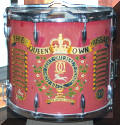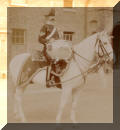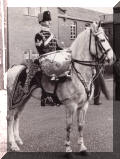Henry McGilchrist
the Kettle Drummer of the
3rd Kings Own
Dragons 1774 –
1810
All pictures are thumbnails,
click for larger view.
The 3rd King's own Regiment of Dragoons
Now renamed the
Queen's Own Hussars originally formed in 1685 as The Queen Consort's
Regiment of Dragoons, the 3rd Hussars won their first battle honour at
Dettingen in 1743.They suffered heavy losses charging French cavalry,
which outnumbered the Regiment by ten to one, but finally overcame to
drive the enemy from the field and at the same time capture two silver
kettle drums, replicas of which are still held by the Regiment.The 3rd
Hussars were active in all the major battles of the Napoleonic Wars,
including those of the decisive Peninsula Campaign front 1808-1814.
The Dragoons
 The Regiments of Dragoons, although listed as Cavalry were
in fact Mounted Infantry and as such were expected to dismount and fight on foot
as required. They were equipped with a shorter sword that the Cavalry and were
also armed with a musket. A Royal Warrant of
1684 ordered that, whilst in
garrison, they were to be classed as Foot and in the field regarded as Horse. To
this end they still manoeuvred to the beat of a drum, the trumpet still reserved
for the regiments of horse. The original regiment would have comprised of six to
eight troops. Each troop was comprised of sixty soldiers, one Quartermaster, two
Sergeants three Corporals, two drummers and two Hautboys (oboe players), besides
commissioned officers. The Regiments of Dragoons, although listed as Cavalry were
in fact Mounted Infantry and as such were expected to dismount and fight on foot
as required. They were equipped with a shorter sword that the Cavalry and were
also armed with a musket. A Royal Warrant of
1684 ordered that, whilst in
garrison, they were to be classed as Foot and in the field regarded as Horse. To
this end they still manoeuvred to the beat of a drum, the trumpet still reserved
for the regiments of horse. The original regiment would have comprised of six to
eight troops. Each troop was comprised of sixty soldiers, one Quartermaster, two
Sergeants three Corporals, two drummers and two Hautboys (oboe players), besides
commissioned officers.
The drummer of the Dragoons was the counterpart of the
Trumpeter of the Horse and although mounted as the rest of his troop was not a
Kettle Drummer. He beat on a single large infantry pattern side drum slung on
his right shoulder and resting on his left thigh. The drummer was responsible
for beating the executive orders whilst in quarters and in the field however it
is unclear what the duties of the Hautboys were. The instrument was a primitive
form of oboe and emitted a piercing noise and although common in civilian
circles was only used by the military exclusively in the Dragoons and Horse
Grenadier Guards.
 Although fine when dismounted, the drum was at a
disadvantage when the Dragoons fought as Horse to this end in
1765 all Dragoon regiments
were ordered to replace their Drummers with Trumpeters. The transition from
mounted infantry to Horse was now complete and the dragoons joined the ranks of
Cavalry. The training of these Trumpeters was clearly seen as a matter of
importance and in
1766 each regiment had to
send two of their Trumpeters to Horse Guards to be perfected in their regimental
duties as Trumpeters Although fine when dismounted, the drum was at a
disadvantage when the Dragoons fought as Horse to this end in
1765 all Dragoon regiments
were ordered to replace their Drummers with Trumpeters. The transition from
mounted infantry to Horse was now complete and the dragoons joined the ranks of
Cavalry. The training of these Trumpeters was clearly seen as a matter of
importance and in
1766 each regiment had to
send two of their Trumpeters to Horse Guards to be perfected in their regimental
duties as Trumpeters  [I].
The change from Drummers to Trumpeters presented a problem for the
3rd Dragoons
regarding the captured a
pair of silver Kettle-Drums
[I].
The change from Drummers to Trumpeters presented a problem for the
3rd Dragoons
regarding the captured a
pair of silver Kettle-Drums ,
In order to still parade these drums one troop would lose a Trumpeter. It was
not until Christmas day
1778 that George III granted
an additional man and horse to the establishment as in other regiments having
kettle-drums. ,
In order to still parade these drums one troop would lose a Trumpeter. It was
not until Christmas day
1778 that George III granted
an additional man and horse to the establishment as in other regiments having
kettle-drums.
Henry McGilchrist – Kettle-Drummer.
Henry McGilchrist a Negro ]
born Jamaica in
1755 was enlisted as a
Trumpeter in
1774 ]
born Jamaica in
1755 was enlisted as a
Trumpeter in
1774 at Greenwich whilst the regiment was at Black Heath Camp. The returns of
1776 list “one black
kettledrummer”
at Greenwich whilst the regiment was at Black Heath Camp. The returns of
1776 list “one black
kettledrummer” and the description books of this period list two blacks with the rank of
Trumpeter, Henry Mcgilchrist
and John Downes another Jamaican
and the description books of this period list two blacks with the rank of
Trumpeter, Henry Mcgilchrist
and John Downes another Jamaican
 . The discharge papers of John Downes make no
mention of him being a Kettle Drummer although being discharged after the
establishment of the rank. It is therefore likely that Henry was the
Kettle-Drummer mentioned in
1776 and possibly from his
enlistment in
1774. . The discharge papers of John Downes make no
mention of him being a Kettle Drummer although being discharged after the
establishment of the rank. It is therefore likely that Henry was the
Kettle-Drummer mentioned in
1776 and possibly from his
enlistment in
1774.
The established rank of Kettle-Drummer was effectively a
Sergeant according to the Musters of
1799-1806,
(the only ones examined in detail as yet). The
1806 -
1809 muster shows Henry McGilchrist Trumpeter (Kettledrummer) paid
£8 5s for
90 days, ( An ordinary
private received
£5 12/6
and a Serjeant
£9 15s).
shows Henry McGilchrist Trumpeter (Kettledrummer) paid
£8 5s for
90 days, ( An ordinary
private received
£5 12/6
and a Serjeant
£9 15s).
The Period of Henry’s Service
The period,
1774 –
1810, for which Henry was
the Kettle-Drummer of the
3rd Dragoons was one
in which the regiment appeared to see no active service abroad. They tended to
move around the country quite a lot and the itinerary gleaned from the
1771-1781
description book demonstrates this :-.
The regiment was in Kettering by June
1774
and from October to March
1775
Northampton In April
1775
they were in Darlington and by May Dalkeith,in Oct
1775
the troop was at Edinburgh Castle but back at Dalkeith by Jan
1776
in March
1776
they were at Coventry and remained there March
1777
In April
1777
they were in Newbury and June Sturminster, June Dorchester where they remained
until Mar
1778.
In April they were in Salisbury, June Hertford, West Stow camp in August
Huntington in August and Stamford December. March
1779
York July Lewes and August Brighton Sept Lewes and Chichester Dec
1779.June
1780
Brighton and Chelsea July Paddington Sept - Mar
1781
At this period there was no established police force and
the army regiments stationed at home served that purpose. They assisted in
maintaining law and order and in the enforcement of customs and excise laws.
They had no regimental barracks and would be billeted on the local population,
when in a particular area it was common for the troops to be dispersed to nearby
towns.
Henry was discharged to pension in November
1810 for “being rhumatic
and worn out from length of service”, aged
56 he was possibly no longer
fit for active service and by the Spring of
1811 the
3rd Dragoons were
with Wellington on the Peninsula.
The Kettle-Drummers today
  The tradition still survives although the original
Dettingen drums were destroyed by fire in the Tower of London in
1855. The existing drums,
copies of the originals, were bought by the Officers in
1856. Made by Messrs Distin
of London in solid silver they are unique musically in so far as they can be
tuned to seven different keys by simply turning one screw. From
1828 the drums have always
been displayed without banners because uniquely the Regiment’s battle honours
are displayed on the drums themselves so replacing the regimental guidon. The tradition still survives although the original
Dettingen drums were destroyed by fire in the Tower of London in
1855. The existing drums,
copies of the originals, were bought by the Officers in
1856. Made by Messrs Distin
of London in solid silver they are unique musically in so far as they can be
tuned to seven different keys by simply turning one screw. From
1828 the drums have always
been displayed without banners because uniquely the Regiment’s battle honours
are displayed on the drums themselves so replacing the regimental guidon.
I am indebted to the
3rd
Hussars regimental museum in Warwick for some of the detail contained in this
appendix.
|